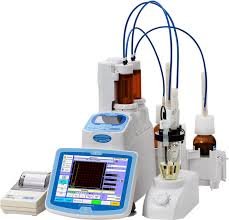Optimization and Standardization of Karl Fischer Titration Equipment.

Optimization and Standardization of Karl Fischer Titration Equipment
Karl Fischer (KF) titration is a widely used technique for determining the water content in various substances, such as chemicals, pharmaceuticals, foods, and oils. The accuracy and precision of this method depend largely on the proper calibration and optimization of the equipment. The terms optimization and standardization refer to ensuring the apparatus is functioning at its best performance and is operating within accepted standards, respectively. Here’s a breakdown of both concepts in the context of Karl Fischer titration:
1. Optimization of Karl Fischer Titration Equipment
Optimization refers to the process of adjusting and refining the operation of the Karl Fischer titrator to achieve the best performance. This involves:
-
Reagent Quality and Composition:
-
The accuracy of the KF titration depends on the quality of the reagents (e.g., Karl Fischer reagent, solvent). Over time, these reagents can degrade, or their composition can change, which can lead to inaccurate results. Ensuring that the reagents are fresh and correctly mixed is essential for optimal titration.
-
-
Electrode Calibration:
-
The electrochemical sensor (or electrode) used in KF titration should be optimized by calibrating it regularly. This ensures that it accurately detects the endpoint of the titration when the water content reaches a certain level.
-
-
Titration Parameters:
-
Factors such as titration speed, voltage, and current are adjustable and can be fine-tuned to optimize the response and reduce error. For instance, slower titration rates might improve precision when measuring very low moisture content, while faster rates might be needed for higher moisture contents.
-
-
Temperature Control:
-
The Karl Fischer titration is sensitive to temperature, and optimal temperature conditions can lead to better reproducibility and faster titration. Maintaining a consistent temperature is important because the reaction rate can vary with temperature.
-
-
Stirring Speed:
-
The speed at which the sample is stirred during titration can impact the consistency of the results. Optimizing stirring speed ensures a uniform reaction between the titrant and sample, reducing variability.
-
2. Standardization of Karl Fischer Titration Equipment
Standardization involves ensuring that the equipment is working according to established protocols and is accurate in its measurements. This is crucial because the results from KF titration must be comparable to standards, and any errors in equipment performance could lead to incorrect results. Key elements in standardization include:
-
Routine Calibration with Known Standards:
-
To ensure the accuracy of the KF titration results, the equipment should be calibrated using a standard reference material with a known water content. This process helps to identify any drift in the instrument’s readings and adjust the titration curve or method accordingly.
-
-
Titration Verification:
-
The method must be verified with a sample that has a known water content. This helps to confirm that the titration results are reliable and consistent over time. A routine check using a certified reference material is often done to validate the method.
-
-
Reagent Standardization:
-
The Karl Fischer reagent itself can change in concentration due to environmental factors. Standardizing the reagent regularly is necessary to ensure that the titration results are accurate. This can be done using a substance with a known amount of water (e.g., sodium tartrate or anhydrous ethanol) to calibrate the reagent.
-
-
Instrument Calibration and Maintenance:
-
Regular maintenance of the titration apparatus is required to maintain accuracy. This includes checking the operation of the burette, electrode, and temperature sensors. Over time, sensors may need to be replaced, and the equipment should be serviced to avoid drift or malfunction.
-
-
Quality Control Protocols:
-
Periodic quality control (QC) checks ensure that the equipment remains within acceptable limits. QC measures might involve testing the equipment under different conditions (e.g., varying humidity levels or sample types) to ensure consistency in results.
-
-
Documentation and Traceability:
-
All calibration, maintenance, and standardization procedures should be properly documented, ensuring traceability for regulatory and quality control purposes. This documentation helps in maintaining consistency across different batches and operators, which is critical for meeting industry standards.
-
Conclusion
Optimization and standardization are critical to ensuring that Karl Fischer titration provides accurate and reliable results for water content analysis. By optimizing the titration process (e.g., adjusting parameters, calibrating electrodes) and ensuring the apparatus is standardized through regular checks and calibrations, the precision of the measurements can be maintained. This not only ensures high-quality results but also helps in meeting regulatory requirements and maintaining the integrity of scientific or industrial operations.
🎓 Discover one of the best Quality Assurance courses available — click below to explore the course that’s shaping future QA skills.

